Group News: Hawaiʻi Island, Maui, and Oʻahu
Hawaiʻi Island Group
What’s Wrong with This Reso?
by Cory Harden, Hawaiʻi Island Group Member | Reading time: 2 minutes
What’s wrong with sending the county’s solid waste to a facility that will turn it into carbon-negative cement, biochar, green hydrogen, and reclaimed water, and start doing so in three short years?
Plenty. Resolution 73, for this facility, skipped normal review at two preliminary meetings, and instead was fast-tracked to the full county council. There, numerous supporters, apparently organized in advance, testified in support. Everyone else got less than a weeks’ notice.
We have been told the resolution was written at the request of a specific company, Yummet, and for its benefit. This is an ethics violation.
CEO Brittany Zimmerman, and perhaps other representatives of Yummet, have been speaking to influential individuals and groups statewide for months. That begs the question of why the CEO of a large company with actual financial backers would spend time chasing county resolutions with no force of law, never mentioning a physical corporate headquarters.
Zimmerman claimed Yummet facilities could remove a billion tons of carbon dioxide a year from the environment. But it takes all the world’s forests to remove 16 billion tons of carbon dioxide a year.
She claimed Yummet’s concrete was certified with the Minnesota Department of Transportation, but the relevant website does not mention Yummet.
Zimmerman also cited nuclear energy as a renewable source.
Under Resolution 73, greenwaste, an example of circularity, now given freely to people farming at a subsistence level, would be taken to make biochar. Farmers would need start paying for mulch. It would be shipped in over thousands of miles and wrapped in plastic. And the biochar wouldn’t be free.
The Resolution 73 facility would need a steady stream of waste. But two “waste-to-energy” proposals (2008 and 2015) for Hawaiʻi Island were rejected, after months of divisive debate, because the island doesn't generate enough garbage to make it cost effective. And on Oʻahu, taxpayers are paying penalties to H-Power because Oʻahu can’t generate enough waste to fulfill the contract.
We wrote to the county council with our concerns and urged them to change their focus to source reduction, reuse, and recycling, and also to the old Hu Honua site, where ill-advised projects may be proposed by investors seeking a way forward. Instead, the site may work well for battery storage for renewable energy, or for hemp processing.
Thanks to Mike Ewall, director, Energy Justice Network; Hannah Hartmann, Master of Science Candidate; Steve Holmes, former Honolulu City Council member; and Kristine Kubat, director of Recycle Hawai’i for their valuable input.
Upcoming Outings
The month of April is known for Earth Day and this year it coincides with Volunteer Week. To honor and care for our earth we are offering a service day on Earth Day, April 22nd, with Hawaiʻi Wildlife Fund (HWF) to clean up a portion of the southern coastline in the moku of Kaʻū. Along with our service work we will be enjoying the coastal ecosystem and learning from the knowledgeable staff of HWF who have years of experience in this area removing many tons of trash. In some areas there are anchialine ponds, native plants and cultural sites like petroglyph fields. The exact location TBA by HWF. The public and members are encouraged to join us for a rewarding day.
Saturday, April 22, 2023
Earth Day Mālama ‘Āina Service (C/E/F/S)
Moku o Kaʻū, South Point area coast
Moderate/3 miles, elevation +/- 100’
In conjunction with Volunteer Week Hawaiʻi, we will do a beach cleanup under the direction of Hawaiʻi Wildlife Fund in the moku of Kaʻū. We will meet in Waiʻōhinu and shuttle to the South Point area then hike to our worksite. This is a very rewarding project cleaning up coastal areas that accumulate trash, mostly plastics, from the great garbage patch. Be prepared for hot dry weather by bringing plenty of water, sun protection, sturdy shoes and lunch. Call leader, Diane Ware, 808-967-8642 by April 10th for instructions on how to sign up with HWF. This will be a culturally sensitive outing.
Kamilo Beach before a cleanup day. Photo: HWF
Kamilo Beach after 4 hours of group cleanup. Photo: HWF
Saturday, April 29, 2023
Escape Road to Puʻu Huluhulu (E/F)
Hawaiʻi Volcanoes National Park, moderate 7.5 miles at 4,000 ft., +/- 600’
We will start out hiking from the Devastation Trail parking lot, up through the beautiful Hapuʻu ʻŌhia forest to Escape Road. Walking Escape Road, we cruise downhill all the way to the Mauna Ulu parking lot. Then we traverse a pahoehoe lava field to climb Puʻu Huluhulu where we can eat lunch. This hike will be enabled by leaving a car at the Mauna Ulu parking lot to transport everyone back to the Devastation Trail parking lot prior to starting the hike. Leader: Linda Larish, call or text 808 657 9640.
Maui Group
Celebrate Earth Month with the Sierra Club Maui Group
by Lucienne de Naie | Reading time: 8 minutes
Enjoy Maui’s Stream and Watersheds
Check out the new Maui April-June hike schedule here which features nine different hike adventures to some of Maui’s iconic streams, pools and watershed areas.
Saturday, April 29 7am- 2 pm: Super Plant Sale plus huge selection of plants, yummy bake sale temptations, select yard sale treasures, bid on gift certificates for local restaurants and businesses. The annual Sierra Club Maui Group plant sale is BACK and will also feature some select gently used yard sale treasures, homemade desserts, and gift certificates. The sale coordinator is long time plant sale donor Barbara Kaneshige of Kīhei Tropical Plants who has volunteered her Maui Meadows yard and garden as the sale location. Please text Barbara at 808-283-6313 to volunteer donations of plants, baked goods, or nearly new yard sale items. Stay tuned for directions to the Super Plant Sale Plus location.
Too Much Traffic. Not Enough Water. Destruction of Natural and Cultural Resources. Who Decides What Part of Our History Survives in South Maui?
Underground springs and shining ponds were once abundant along Maui’s sun-drenched south shore. Nearshore and offshore reefs teemed with fish. Rocky shorelines provided a network of tide pools rich with multiple species - fish, mollusks, sea urchins and eels. The shores and uplands of “Kula Kai” (modern day “Kīhei”) and Honuaʻula (modern day “Wailea Resort” and “Mākena”) were settled by Kānaka Maoli for a thousand years or more.
Four large fishponds along the shore bear mute evidence to the settlements that once flourished in this land of abundant fish and farmable slopes, but what happened to the rest of South Maui’s pre-contact history? In a phrase: it’s been largely “replaced” with a western colonial version of “tropical paradise.” South Maui today boasts numerous condominiums, hotels and destination resorts - all welcoming visitors from across the globe. What they have replaced are the remains of Hawaiian dwellings, traditional trails, boundary walls, fishing shrines, wells, salt pans, ceremonial sites and even burial grounds. Only a remnant of south Maui’s kanaka historical and cultural resources remains, and its fate is on the block as major developments are proposed for the remaining coastal plain.
Kānaka Maoli groups are speaking up to reverse this trend and take a leading role in future decision making - for the areas still remaining. They are turning to county and state agencies and the courts - looking to reclaim historically and culturally significant areas of South Maui and halt further destruction. Sierra Club Maui Group volunteers have offered their support for many of these efforts. Here’s a quick view of what has happened in South Maui during over the last year, through the lens of three major proposed developments:
Wailea 670 owners have refused to tell State Historic authorities that remains of this 100 ft long rock terrace and the complex of other traditional kanaka archaeological features around it even exist!! It is called a “delisted” site, even though three qualified archeologists verified that it was a traditional site. The complex is supposed to be protected within a preserve as part of the 2016 settlement between landowners and community groups, before any final County Phase II approval was issued. Unfortunately, project refused to verify the correct location of the site with the Maui Group and allies and instead pushed through final county approvals. This action was repeated for numerous other ancient remains protected in the settlement agreement, leading to the Sierra Club breach of settlement complaint.
“Honuaʻula/Wailea 670 development”- These are the ancient lands of Paeahu, Palauʻea and Keauhou. The Maui Group and kanaka allies, Maui Unite, challenged the 2012 Environmental Impact Statement (EIS) for this 1400-unit luxury oriented development. The sloping land with dramatic lava rock formations includes five major gulch systems, an extensive cultural landscape with thousands of pre-contact structures and a number of rare and endangered native plants and animals. The accepted EIS protected only 40 acres of this sensitive habitat and claimed most natural and cultural resources simply were not there. An entire unique cultural landscape and rare dryland forest ecosystem would have been lost if citizens had not stepped up with legal action in 2012.
A landmark 2016 settlement decision between the citizen groups and the landowners defined a 160-acre preserve for native flora and fauna and historic sites, and provided for a federal Habitat Conservation Plan to manage most of the preserve. Unfortunately, in 2021, the landowners abandoned the voluntary habitat plan specified in the settlement and the essential funding stream it mandated. The mainland investor owners also claimed that all archaeological preserve boundary issues were resolved - but they were not - and some important parts of the cultural landscape remained at risk. The Maui Group and Maui Unite made the difficult and costly choice in January 2022 to formally allege breach of the 2016 settlement. The resulting legal snarl has involved, hundreds of hours; claims and counterclaims; landowner demands for broad categories of Sierra Club communications and records and other onerous demands on community volunteers. AUWE!
In May 2022, our attorneys, Bianca Isaki and Lance Collins, finally filed a motion asking the Maui judge to rule that the landowner’s actions constituted a Strategic Lawsuit Against Public Participation (SLAPP) action. Sierra Club’s lawyers pointed out that the sheer volume of materials requested was extraordinary and served no purpose except to burden community volunteers and attorneys with time-consuming responses - taking time away from advocating for the real facts of the case. Currently the matter is awaiting hearing at the State Intermediate Court of Appeals (ICA).
Many Maui donors stepped up to help make the ICA appeal possible. If it had not been filed, the overwhelming legal demands of the case would have continued to bury our attorneys and volunteers and keep them from preparing our case. The Maui community supports the best preservation efforts possible for the unique ecosystems of Wailea 670.
“This amazing land holds so many stories of our past, and offers us many examples of how to use traditional kanaka knowledge to shape our future,” says Maui Group Conservation Committee member Clare Apana. “We must stand with this land.” Tax deductible donations to support the Sierra Club Maui Group’s efforts to truly protect these lands by donating online here or mailing checks made out to the Sierra Club Foundation, memo line: Maui Group, to Sierra Club Maui Group, P.O. Box 791180, Paia, HI 96779.
A dramatic rock wall following the sleep contours of one Ledcor parcel was slated to be removed, even though kanaka pointed to its alignment with pre-contact ahupuaʻa boundaries.
Ledcor “Wailea Hills” Development - These are the ancient lands of Paeahu and Palauʻea. The Maui Group and allies, Maui Tomorrow and Hoʻoponopono O Makena, successfully challenged the 2021 Final Environmental Assessment (FEA) for a 57-unit luxury development on 23 steep hillside acres adjoining a county park. In 2019, Canadian developers Ledcor purchased rights to this parcel and over 100 other acres of undeveloped lands in the posh (and water hungry) Wailea Resort Master Planned Development. Ledcor proposed exclusive gated communities or upscale resort commercial on the eight parcels - but sought permits for each as a separate project (“segmentation”) while alleging that there were “no significant impacts.”
The largest Ledcor Wailea parcel, at 46 acres, holds a large proportion of the remaining Kanaka Maoli archaeological sites in the entire ahupuaʻa of Paeahu (modern day “Wailea”.) Scores of interconnected kanaka heritage sites, like this walled terrace shown above, were slated for destruction before legal action forced a new archaeological study. The old study only proposed one site in a steep gulch for preservation.
The Sierra Club and allies challenged the Final EA for very incomplete archaeological surveys; wasteful water use; drainage impacts and segmentation of impacts of the proposed multi-parcel “Wailea Hills” development, as described on the Ledcor website. The court ruled in favor of the Maui Group and allies in October 2022 and Ledcor recently began preparations for a full EIS that proposes nearly 1,000 units over 135 acres. The Maui Group and allies will need to keep tabs on the EIS process. Key issues are the cultural use and importance of several of the parcels - where NO historic preservation is proposed; severe impacts these hilly projects will have on Wailea’s already overwhelmed drainage systems and ocean water quality and the high demand for scarce water resources imported from central Maui to the desert of South Maui.
Two stone burial platforms and the iwi and numerous burial goods associated with the two high status kanaka women resting there were removed in 1987 to make way for the construction of the “Haleakalā wing” of the Grand Wailea Hotel. Red circle is the location of the burials. Portions of the burial site were never properly tested, yet additional construction is being proposed by resort owners to expand the "Haleakalā wing" in this same area.
Grand Wailea Resort Expansion - These are the ancient lands of Paeahu and hold south Maui’s most extensive traditional kanaka burial complex. In January 2020, three kanaka groups: Hoʻoponopono O Makena, Malama Kakanilua and Pele Defense Fund challenged the Special Management Area permit application to add 135 rooms to the 780-room resort. The groups asked for a chance to tell the real story of the 30-year-old resort: that it was built on an ancient burial grounds and displaced hundreds of carefully interred traditional kanaka burials and a rich array of ancient artifacts during its construction. Many other important cultural sites, such as a walled heiau (ceremonial worship site), remains of ancient dwellings, and the centuries old “kings trail” along the south Maui coast were all wiped off the face of the land - along with two natural stream gulches that were part of the area’s unique ecosystem.
1987 B&W shot of one of the burial platforms before it was removed and disinterred. Its original location on a high bluff gave the two kūpuna a timeless and unobstructed commanding view of the ocean and the mountains.
The rocky promontories and magnificent sand dunes which once dominated the 36-acre Grand Wailea site were also bulldozed aside and replaced by gleaming banks of ocean view hotel rooms; towering parking structures; an exclusive spa; and numerous water-hungry swimming pools, water features and artificial ponds. In spite of this systematic destruction of the natural land forms, and the the removal or relocation of every vestige of over 1,000 years of Kanaka Maoli settlement on the lands, the Grand Wailea ironically overlooks its own shameful development history and beckons its guests to “discover a retreat shaped by nature and inspired by culture.”
The three kanaka groups presented numerous experts during their contested case proceedings to testify to the environmental, cultural and psychological impacts past construction, and proposed new construction on the resort grounds would cause. One of the most heartfelt concerns was the resort’s refusal to acknowledge, account for and repatriate the hundreds of iwi kūpuna (traditional burial remains) which were removed from the site to various other unmarked locations during the project’s construction in the late 1980’s. After three years, the hearing officer issued an opinion that the resort’s permit should be denied until their plans better address wasteful water use; traffic and drainage impacts; protection of a natural spring and access for traditional cultural use.
This is where these two kūpuna were “relocated” after removal, along with hundreds of other iwi kūpuna “inadvertently disturbed” by the hotel construction. This “preserve” only has “views“ of a multi-level parking structure and the busy “Wailea wing” of the resort. The Wailea wing is also proposed for expansion towards the small burial preserve - likely encroaching more on its limited space.
The Sierra Club Maui Group has supported this important cry for respect and true justice with testimony, donations and expert witnesses. Kanaka groups presented their concerns to the Maui Lānaʻi Island Burial Council in 2022 and received a unanimous support for a policy of no further ground disturbing activities on the Grand Wailea sites due to the high incidence of kānaka iwi kūpuna unaccounted for after construction and burial fragments scattered by earlier construction throughout the resort site.
Our kanaka allies need all our support to bring back respect to this sacred site.
Donate online at https://protecthawaiianburials.com/donate/
World Water Day at UH Maui Campus
by Tara Apo | Reading time: 3 minutes
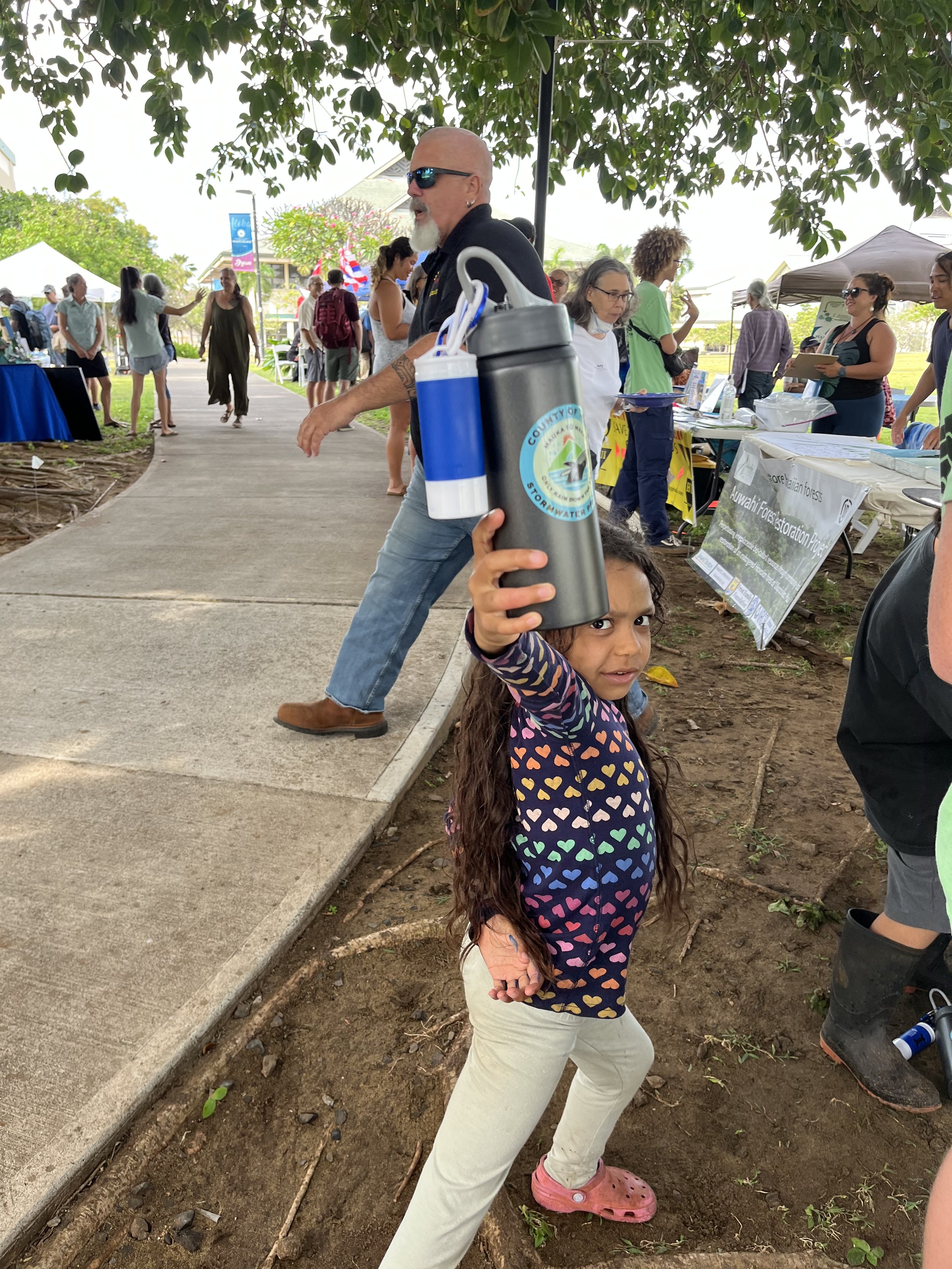
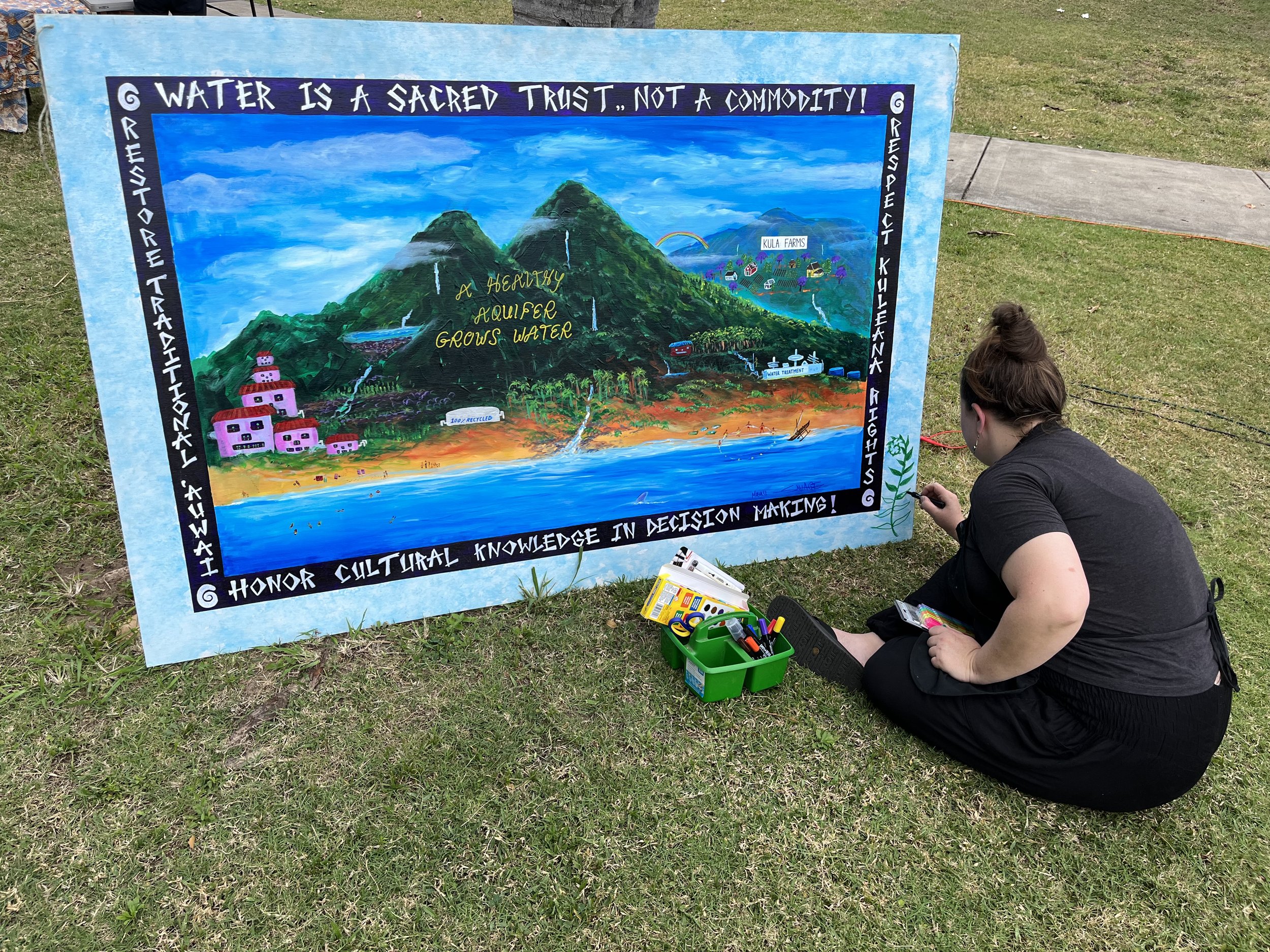
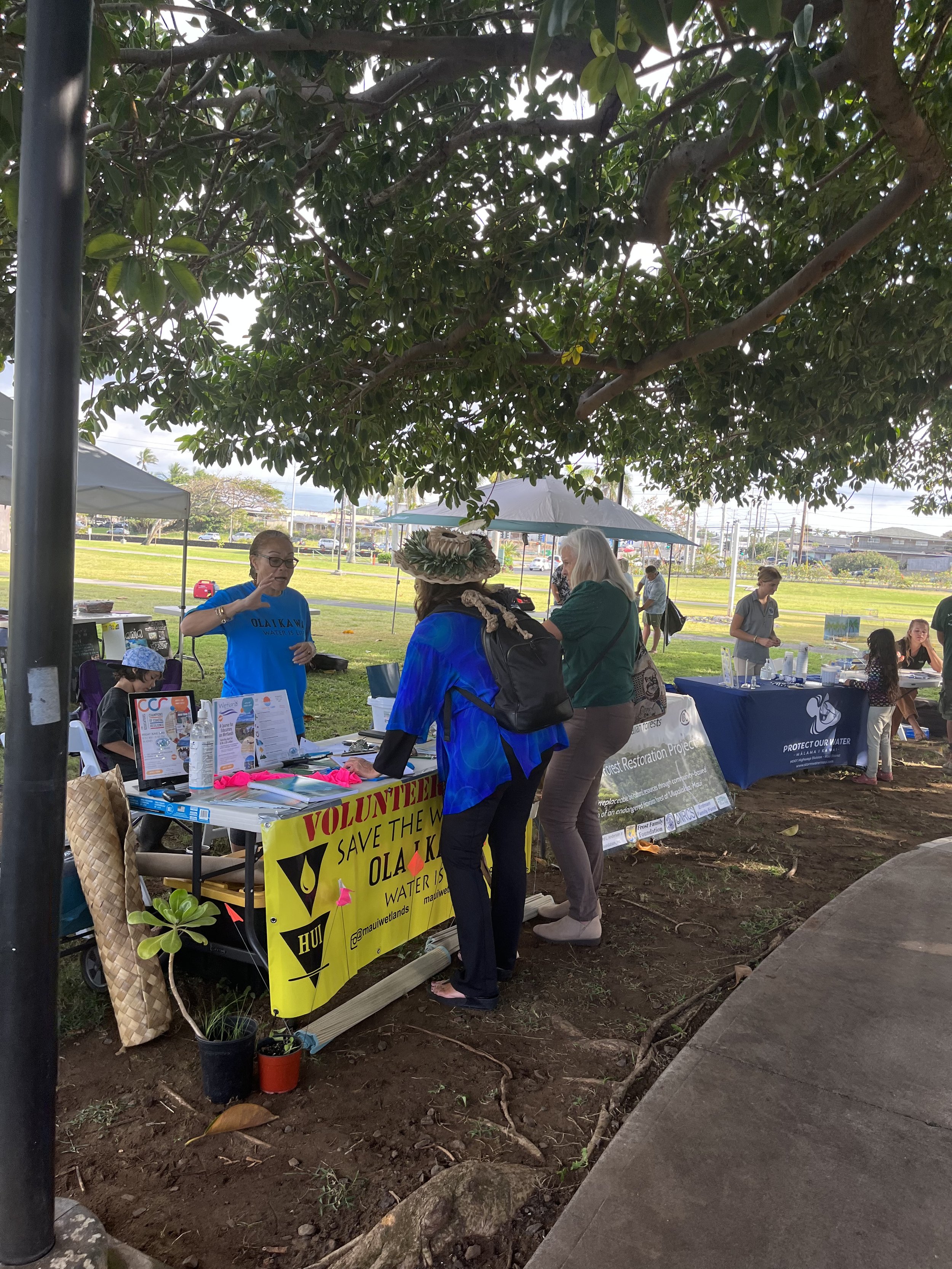
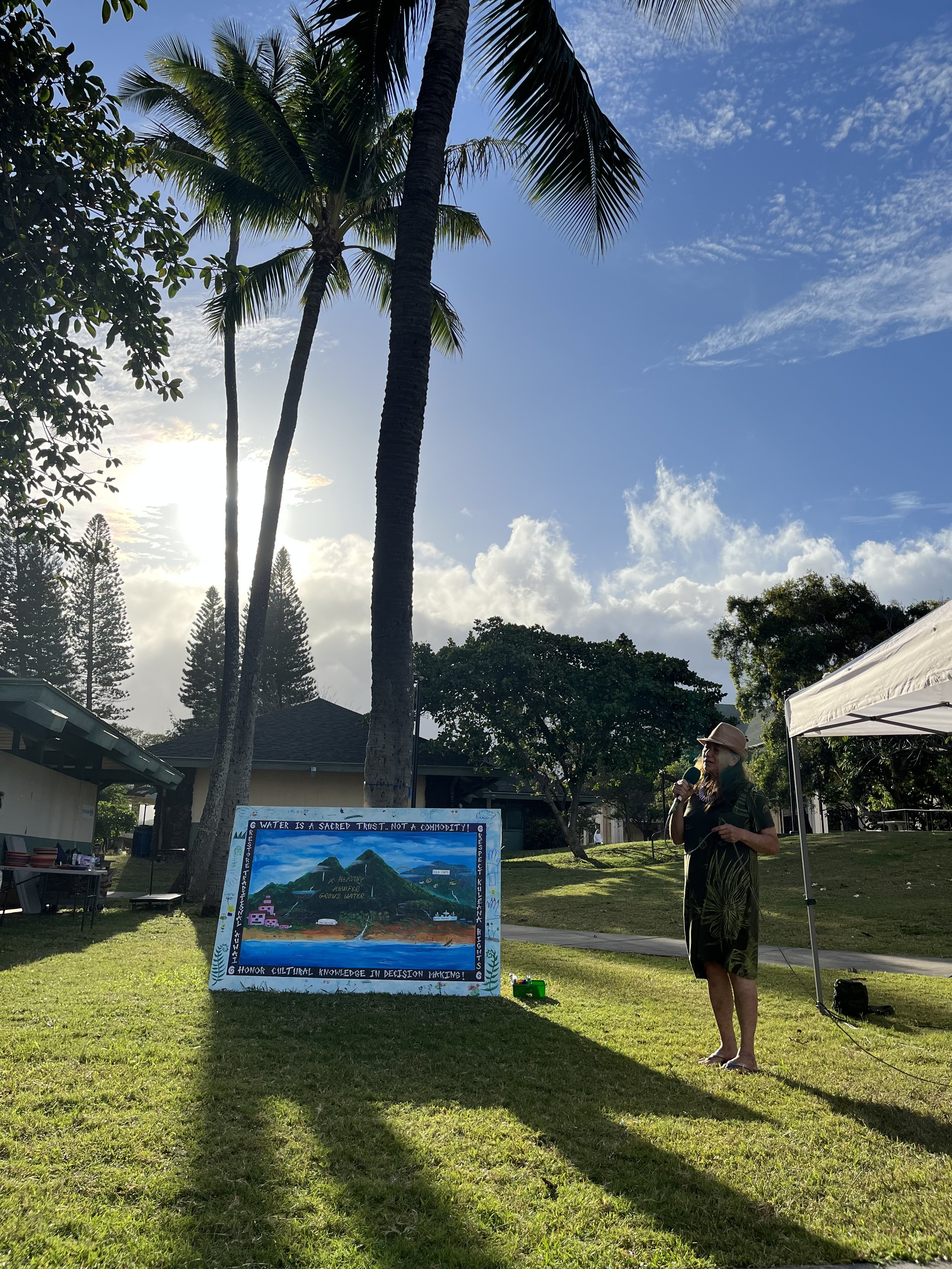

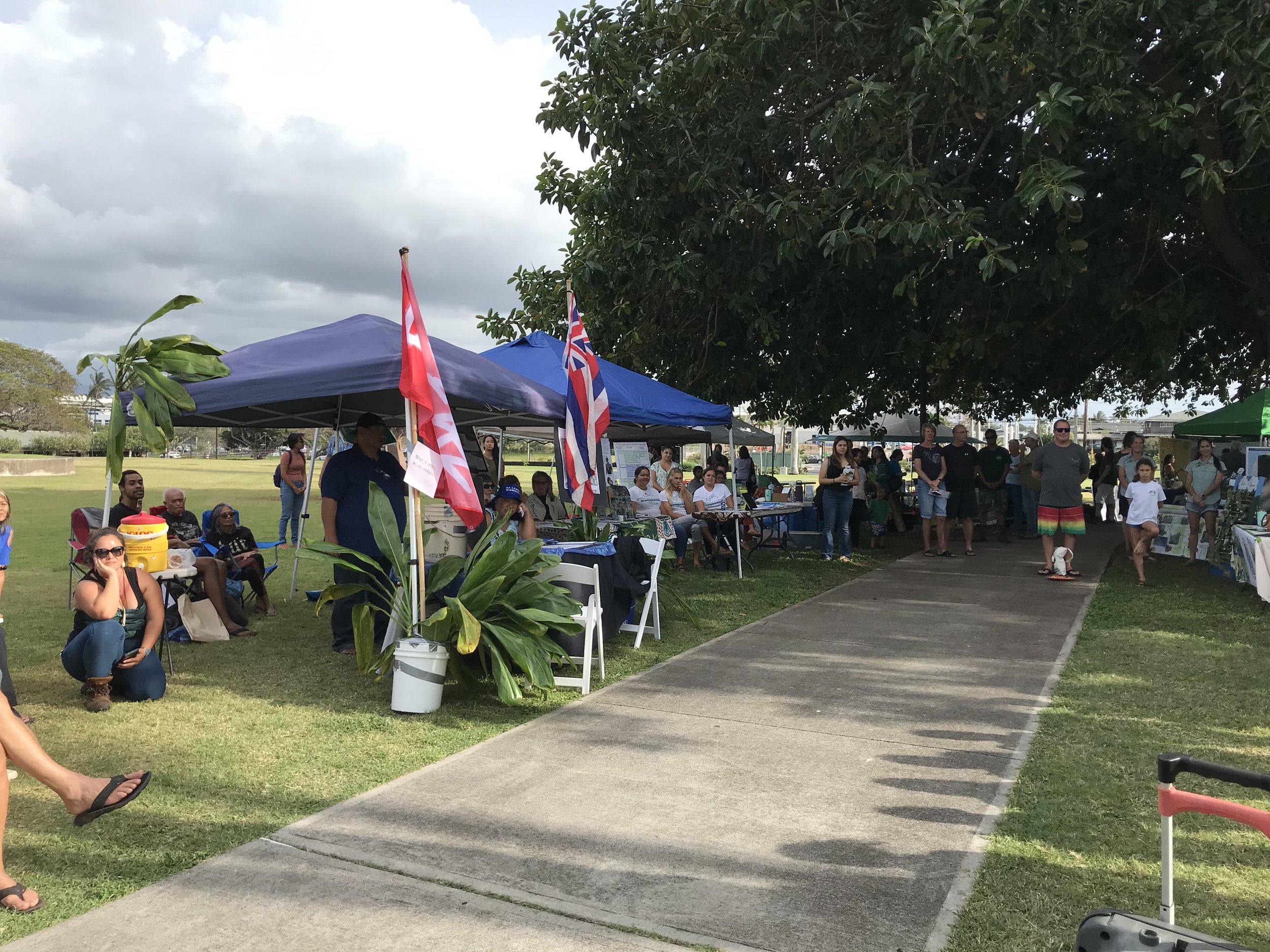
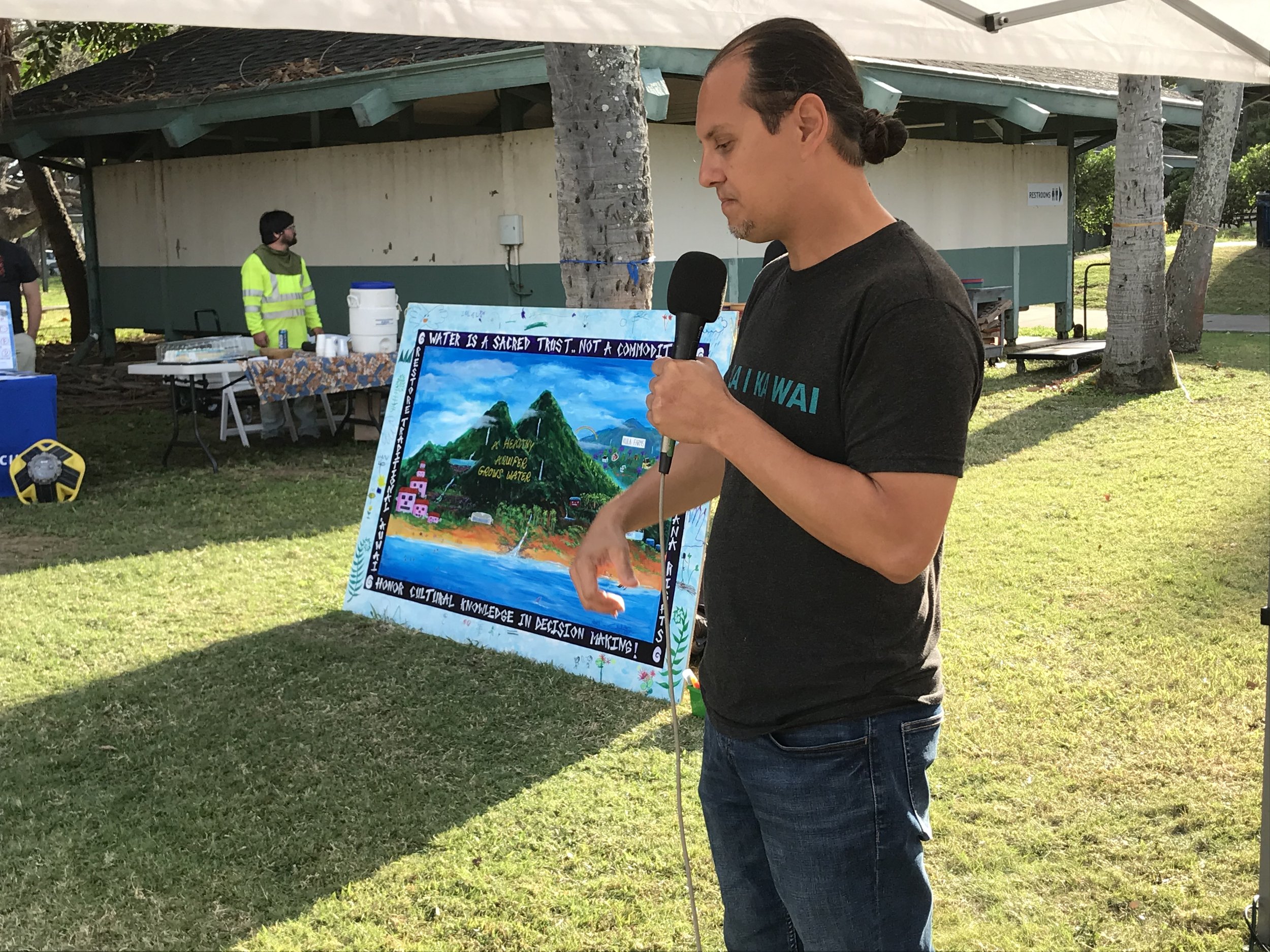

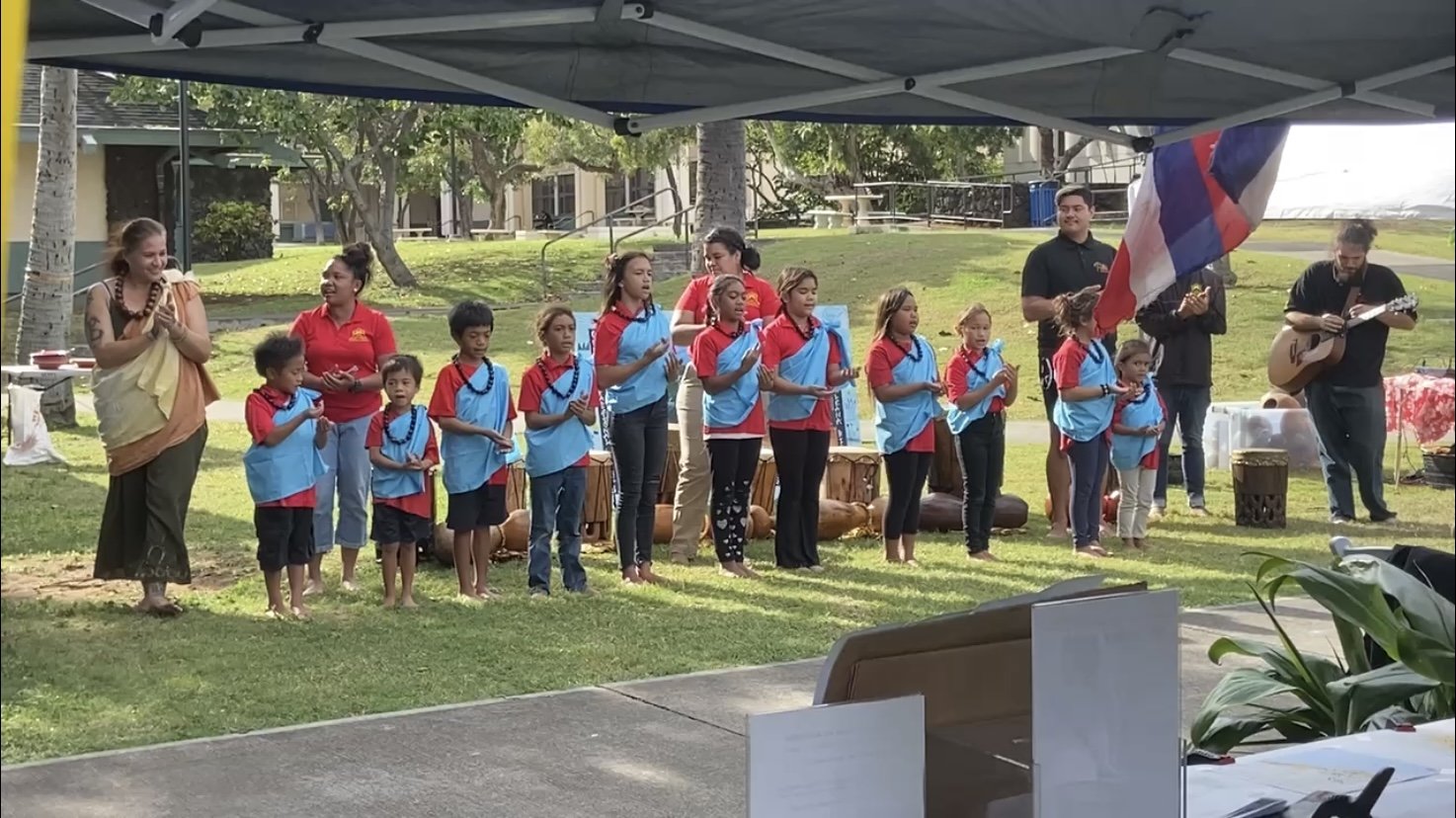
On March 22nd, the Sierra Club Maui Group and the Student ʻOhana for Sustainability gathered with community members and nonprofits from across the island for World Water Day at the UH Maui Campus. The event opened with a beautiful blessing by Kahu Alalani Hill, after which attendees perused booths to learn about efforts to take care of our water resources and ecosystems and discover opportunities for involvement. Donata Masucci and Gary Savage contributed a heartfelt and interactive mural depicting a beautiful vision for Maui’s water future, and keiki enjoyed participating with handprints and drawings, with the help of local artist Sarah Adams. Cake and pizza generously donated by Flatbread Pizza Company were served.
Later in the day, the keiki of Ke Kula o Piʻilani Hawaiian Immersion School shared ‘oli (chants), mele (songs), and manaʻo (thoughts) about the importance of water. We extend the deepest mahalo to the keiki and their kumu and parents for joining us during their Spring Break vacation!
During a community talk story session, Hōkūao Pellegrino, President of the Hui o Nā Wai ʻEhā shared exciting updates about the near completion of a historic ʻauwai restoration project for North Waiheʻe stream, which will help ensure water for kalo farmers, many of whom, for the past several decades, have depended on unreliable water provisions from the Wailuku Water Company (formerly Wailuku Sugar Company) ditch system. The dream, he said, is to bring back as many ʻauwai as possible in the Nā Wai ʻEhā system, and work to restore the region’s traditional abundance of loʻi kalo.
Trinette Furtado shared about the Lāʻie Mauka Wetland Restoration Project in South Maui, facilitated by the Save the Wetlands Hui, and spoke about the important function of wetlands within our island ecosystem – serving as habitat for critical native and endangered bird and insect species, helping to prevent flooding and sedimentation/brown water events, and serving as a filter before water enters the ocean. Clare Apana, of Mālama Kakanilua spoke about bringing justice to water and called attention to the fact that hotels in Wailea, one of the driest areas of Maui, are our Countyʻs largest water users, relying on water from Wailuku and Nā Wai ʻEhā, while people from those areas still have to go without water. Autumn Ness, from Beyond Pesticides Maui, alerted the community about a PFAS contamination at Kahului Airport, which has infiltrated our oceans, untreated, via storm drains, and has also leaked into groundwater supplies below the airport. According to the EPA, Kahului’s groundwater is 80 million times over the EPA threshold for PFAs, though no drinking water supplies have been affected. The Department of Health is currently working to address the problem. To close the talk story portion, Sierra Club member and community activist Amy Chang shared mele about wai.
Mahalo nui loa to all of the community members who joined us for World Water Day, to the Student ʻOhana for Sustainability for collaborating with us, and to UH Maui College for hosting our event.
A special mahalo to Flatbread Pizza Company and Gary and Donata for the generous donations, Tim Wolfe of Akamai Videos for donating the sound system, Ann Wallace and Scott Warden who enthusiastically hosted the Sierra Club Maui Group booth, Jonah Lion and the volunteers who helped set up the event, and to all of the organizations who shared time with us:
Auwahi Forest Reforestation Project, Beyond Pesticides Hawaiʻi, Coral Reef Alliance, County of Maui Department of Water Supply, County of Maui & State DOT Stormwater Programs, Hui o ka Wai Ola, Hui o Nā Wai ʻEhā, Ke Kula o Piʻilani, Kipuka Olowalu, Lāʻie Mauka Wetland Restoration Project, Malama kakanilua, Maui Hikina Huliamahi Initiative, Maui Huliau, Maui Nui Makai Network, Maui Nui Marine Resource Council, Maui Tomorrow, Mauna Kahālāwai, Watershed Partnership, Nā mea ʻike ʻia, Sierra Club Maui Group, State Department of Aquatic Resources, State Department of Forestry and Wildlife
Ola i ka wai!
Upcoming Outings
Saturday April 1, 2023
Old Haleakalā Trail (C/E)
Haleakalā, 5 miles
Hike down the segment of the Old Haleakalā Trail from Crater Road to the top of Olinda Road, on the path described by Jack London and Mark Twain. We will meet at the Waihou Spring Trailhead near the top of Olinda Road and shuttle to the top. It is almost all downhill, with some rocky areas in the beginning and then mostly pasture land. There is a video of the trail from the trial leading to access being allowed. Although this is a relatively short hike, it is rated moderate/strenuous because of some steep gulch traversals and the 2,500′ elevation change.
Leader: Rob Weltman, robw@worldspot.com
Sign up
Saturday April 8, 2023
Twin Falls (C)
Haʻikū, 4 miles
Meet at Haʻikū Community Center at 8am. This is a very pleasant hike with shade and sun. Crosses streams several times. We will hike about halfway to twin falls and veer right to several waterfalls and swimming pools. Bring a swimsuit if you care to get wet. A hiking stick would be useful in places.
Leader: Kit Carlan, kit.carlan@gmail.com
Sign up
Saturday April 15, 2023
Kōkua Day at Fleming Arboretum, Pu‘u Mahoe (C/E/S)
ʻUlupalakua, 1 miles
Help maintain the Fleming Arboretum at 2600 feet in ʻUlupalakua, sanctuary to many endangered native dry land forest plants. Awesome views of La Perouse (Keoneʻōʻio) coast and Kahoʻolawe. Bring a light jacket, lunch and gloves. It is recommended to have shoes with ankle support in case we are working on uneven ground. Meet 9am at the ʻUlupalakua Ranch Store. Estimate 3 hours of work. Refreshments available. A BYO lunch will be at the Fleming cabin with a great view of South Maui. Limit 20.Leader: Rob Weltman robw@worldspot.com
Sign up
Sunday April 16, 2023
Kapalua Coastal Trail Hike and Farewell to Our Beautiful Kōlea (C/E)
West Maui, 3.5 miles
Meet in the D.T. Fleming Beach Parking Lot, left side, at 8am. We will walk along the coastal path, a combination of asphalt, gravel, and rocky trail. This should be a great opportunity to photograph our beautiful kōlea (Pacific Golden Plover) gathering on the grassy lawns in their elegant breeding plumage in preparation for their 3,000-mile en masse migration to their breeding grounds on the Arctic tundra. After a stop at Kapalua Bay, we will return to Fleming Beach. Although the footing can be rough in places, this is an easy three and a half mile round trip hike. There are restrooms at each end of the walk. There is an optional detour to Makāluapuna Point on the way back to see the jagged rock formation known as Dragon’s Teeth and to walk the labyrinth for those interested. Swimming and snorkeling are excellent at both DT Fleming Beach and Kapalua Bay, so bring appropriate gear if you wish. Snack/lunch on the beach at Kapalua Bay. Bring water and reef-safe sun protection.Leader Annie Schultz 808-344-6628 or acm_schultz@hotmail.com
Sign up
Saturday April 29, 2023
Hāmākua Mālama Service Outing (C/E/S)
Ha‘ikū (Kaupakulua Ahupuaʻa), 2 milesHelp clear away abandoned rubbish from gulches in Ha‘ikū’s Hāmākua Coastal Preserve and re-plant native species. Tools, snacks, trash bags etc will be provided. Co-sponsored by Mālama Hāmākua
Leader: Lucienne de Naie huelogrl@icloud.com
Sign up
Sunday April 30, 2023
Makamakaʻole Stream (13 Crossings) (C/E)
North Shore, 2 miles
Beautiful hike with many stream crossings and waterfall at the end. Bring water shoes, lunch, water, swimsuit. Limit 10. Meet at Waiehu Golf Course parking lot 8am to carpool.
Leader: Ann Schultz, acm_schultz@hotmail.com or 808-344-6628.
Sign up
Friday May 5, 2023
Pilale Bay Hike
East Maui, 3 miles
Hike to Pilale Bay down a steep slope to explore Halehaku stream, Halehaku heiau and remains of a Hawaiian settlement. Bring water and snacks. Limit 10. Meet at 8am Haʻikū Community center.
Leader: Miranda Camp mauimiranda@hotmail.com
Sign up
Sunday May 7, 2023
Līpoa Trail (C/E)
South Maui, 3 miles
An easy stroll along Kīhei’s newest trail – around the Maui Research and Technology Park area, now called Līpoa, Maui. The trail crosses former pasture land and runs along the South ridge of the Waipuilani Gulch, then finishes in passing by the Kīhei Charter School and Maui Brewing Company. There are major development plans for this area; this is an opportunity to enjoy the views and consider what type of development may be in the best interest of the community. Almost no shade, so bring sun protection and water. There are a few short steep sections on gravel. Meet across North Holopono Street from the MEDB – goo.gl/maps/y1htCAb2ZkU3Hzqu5.
Leader: Rob Weltman, robw@worldspot.com
Sign up
Oʻahu Group
Upcoming Outings
Sunday, April 9, 7:45-11am
Mālama Tree Crew: Pālehua Service Project
Native forest restoration.The work is in Akupu Enclosure, restoring ʻelepaio habitat. Tasks include planting, weeding, watering, fertilizing and berming. Please bring water, a snack, and gloves. There may be some mosquitoes so long pants and long-sleeve shirts are recommended. Meet at Makakilo Community Park at 7:45am. RSVP to leader Randy Ching at makikirandy@yahoo.com.
Sunday, April 16, 9am-12pm
Wāwāmalu Beach Service Project
Help return Wāwāmalu Beach to its native/natural status after years of off-road abuse and inattention. Seed collection and sowing, as well as removal of invasive plants on tap. Personal pickaxes welcome. Bring closed-toe shoes/boots, gardening gloves, sunscreen and water flask (iced refill available, no plastic water available). Meet 9am at western access area just left off eastern driveway for Sandy Beach Park. RSVP to leader Reese Liggett at wliggett@twc.com. Co-leader Suzan Harada.
Sunday, April 30, 8am
Mālama Tree Crew: Ala Mahamoe Tree Maintenance
1,000+ trees were planted in this area by volunteers led by Professor Mora, in partnership with The Outdoor Circle, Mālama Learning Center, Ko‘olau Mountain Watershed Partnership, and the Garden Club of Honolulu in 2018. Unfortunately it was a rough winter and many trees died. However in the years since, we have planted almost a thousand trees to re-establish the native watershed—and most of them have survived! Help us keep them thriving! We will be watering, weeding, and clearing debris from around these recently planted trees. Meet at 8am at the gate between 1800 and 1812 Ala Mahamoe St. Tools and refreshments provided. Bring long pants, long-sleeve shirt, water, hat, sunscreen, gloves. Reservations required at least 1 day prior to makikirandy@yahoo.com.









